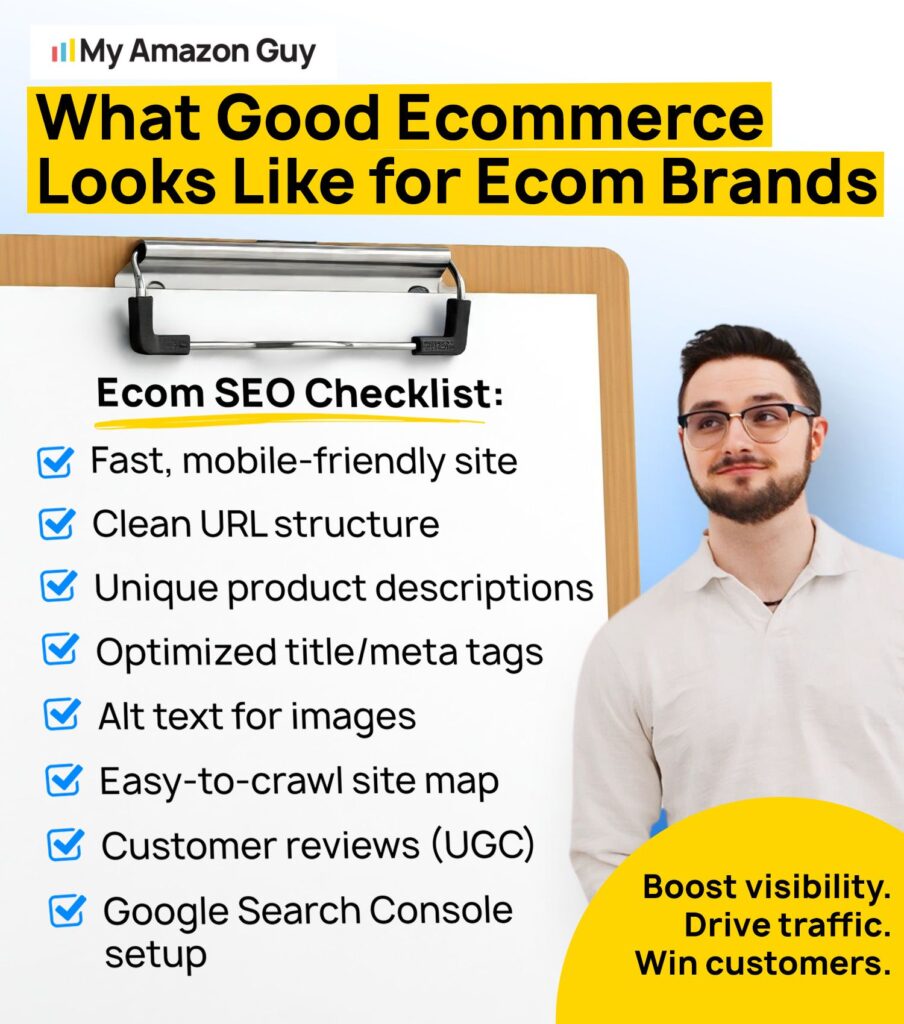
Now that your e-commerce site is live, what’s the next step? Launching doesn’t mean you can sit back and wait for sales to happen; you need strong e-commerce growth strategies to actively drive traffic and increase conversions.
Many sellers assume that once their site is live, the hard work is over and everything will run smoothly on its own. This is a misconception because true growth requires a post-launch strategy that continuously improves traffic, conversions, and customer engagement.
A well-designed strategy can boost site visits, optimize clicks, and maximize revenue opportunities. By implementing actionable growth tactics, sellers ensure their efforts in building the site translate into measurable results.
This guide walks you through seven proven strategies to grow your e-commerce store after launch. By the end of this article, you’ll have a clear plan to drive traffic, improve conversions, and build loyal customers for long-term success.
Table of Contents
Ready to Scale Beyond Launch?
Our e-commerce experts can help you create strategies that drive traffic, boost revenue, and sustain long-term growth.
Why an E-commerce Growth Strategy is Critical After Launch
80% of e-commerce startups fail in their first year, and a major reason is that most sellers focus only on launching their site without planning for post-launch growth. Having a clear e-commerce growth strategy ensures your brand stays top-of-mind, keeps customers engaged, and drives continuous improvement through feedback and optimization.
A strong post-launch plan helps monitor performance, increase revenue, and maintain a competitive edge in a crowded market. By tracking customer behavior, addressing issues quickly, and implementing ongoing campaigns, sellers can build loyalty, reduce churn, and expand their reach well beyond the initial launch.
7 Proven E-commerce Growth Strategies
With so many “expert” tips and online advice floating around, it can be confusing to know which strategies are actually effective. The following seven strategies are proven to drive traffic, increase conversions, and build long-term customer loyalty for your e-commerce store.
1. Use Paid Ads to Drive Traffic and Boost Sales
Paid advertising is one of the most effective ways for e-commerce sellers to drive traffic, especially since about 78% of consumers are influenced by ads when making purchase decisions. With the right strategy, sellers can reach highly targeted audiences and convert clicks into measurable revenue.
Platforms like Google Ads are particularly powerful for e-commerce campaigns, offering advanced targeting, a massive user base, and cost-effective advertising through low CPC rates. On average, Google Ads delivers a ROAS of 200%, meaning every $1 invested can generate $2 in revenue, making it a scalable option for growth-minded sellers.
Successful campaigns start with clear goals, thorough keyword and audience research, and compelling ad copy linked to targeted landing pages. Incorporating retargeting, promoting top-performing content, and continuously analyzing metrics ensures that every ad dollar contributes to higher conversions, increased sales, and long-term customer engagement.
2. Improve Search Visibility with SEO
Search engine optimization is essential for driving long-term, organic traffic to your e-commerce store. Without a proper SEO strategy, even the best products may remain invisible to potential customers actively searching online.
Following an SEO checklist after launch ensures your site is set up for success, covering essentials like a fast, mobile-friendly design, clean URLs, and unique product descriptions. Optimizing title tags, meta descriptions, alt text, and customer reviews further improves search visibility and increases click-through rates.
Regularly monitoring your site with tools like Google Search Console and maintaining an easy-to-crawl sitemap helps identify issues and opportunities for improvement. By implementing a consistent SEO strategy, sellers can sustain traffic growth, strengthen brand authority, and complement paid advertising efforts effectively.
3. Use A/B Testing and Heatmaps to Improve Conversions
Testing is one of the best ways e-commerce sellers can determine whether their site design, messaging, or checkout flow actually works. By observing customer behavior, you gain a clear understanding of what drives engagement, where users get frustrated, and how to improve the overall experience.
Heatmaps provide valuable insights into user interactions on high-traffic pages, showing where visitors click, how far they scroll, and which elements capture attention. These visual tools reveal pain points, like broken links, ignored calls-to-action, or sections of content that aren’t seen, giving sellers a roadmap for improvement.
A/B testing then turns these insights into measurable actions, validating which changes actually increase conversions, average order value, or reduce cart abandonment. By iterating continuously, testing one variable at a time, sellers create a data-driven approach that ensures every update improves performance and maximizes post-launch growth.
Boost Your E-commerce Growth Now
Don’t let your website traffic go to waste; turn every click into profit with proven post-launch strategies.
4. Increase Average Order Value (AOV)
Part of a strong post-launch e-commerce strategy is increasing your Average Order Value to get more revenue from existing traffic and customers. By focusing on upselling, cross-selling, and product bundling, sellers can encourage shoppers to spend more without significantly increasing acquisition costs.
Tactics like free shipping thresholds, personalized product recommendations, and limited-time offers create incentives for customers to add more items to their carts. Using data from past purchases and browsing behavior ensures these suggestions are relevant, valuable, and more likely to convert.
Customer loyalty programs and flexible payment options further motivate higher-value purchases while fostering repeat business. Regularly analyzing AOV data, testing strategies, and optimizing the checkout experience ensures that these efforts consistently contribute to profitability and long-term growth.
5. Retarget Shoppers and Build Loyalty
Owning your e-commerce site gives you access to valuable customer data that can power highly effective remarketing and retargeting campaigns. By analyzing this data, sellers can re-engage visitors who didn’t convert and nurture existing customers through personalized messages across multiple channels.
Segmenting your audience based on behavior, like cart abandoners, product viewers, or past purchasers, allows you to deliver relevant, tailored ads and email campaigns. Dynamic ads that showcase the exact products a user viewed or complementary items increase the likelihood of clicks and conversions.
Optimizing the customer journey with sequential messaging, urgency-driven offers, and loyalty incentives guides users through awareness, consideration, and purchase stages. Continuously testing ad creatives, analyzing performance metrics, and rotating content ensures your campaigns stay effective while maximizing ROI.
6. Partner with Influencers to Grow Your Brand
About 69% of consumers trust influencer recommendations, making influencer partnerships a powerful way to grow your e-commerce store post-launch. By collaborating with the right influencers, sellers can increase brand awareness, generate authentic content, and drive conversions effectively.
Strategies like exclusive product drops, social media challenges, and product seeding help create excitement and urgency while encouraging user-generated content. This type of authentic content builds credibility and allows the influencer’s audience to see real-life use of your products.
Selecting influencers whose values and audiences align with your brand is critical, and setting clear goals ensures measurable results. Tracking engagement rates, conversions, and promo code usage allows sellers to optimize partnerships and maximize ROI for long-term growth.
7. Track Performance and Optimize Continuously
Continuous tracking is a must for any e-commerce site that wants to achieve long-term success. By monitoring KPIs like conversion rate, average order value, traffic sources, and customer behavior, sellers gain actionable insights to guide every post-launch decision.
Optimization should be an ongoing process, using data from analytics tools to identify friction points and improve the user experience. A/B testing, heatmaps, mobile optimization, and streamlined checkout processes ensure your site remains efficient, engaging, and conversion-focused.
Beyond UX, continuous improvements extend to SEO, content marketing, targeted campaigns, and customer retention strategies. By combining systematic tracking with iterative optimization, sellers can adapt to market changes, increase sales, and build lasting customer loyalty.
FAQs About Post-Launch E-commerce Growth Strategies
How soon should I start implementing a post-launch strategy?
You should start immediately after your site goes live. Post-launch strategies are critical for maintaining momentum and capturing early customer behavior.
Which strategy drives the fastest traffic to my e-commerce store?
Paid advertising, especially Google Ads or social media campaigns, typically delivers the fastest results. Combining it with retargeting maximizes ROI from initial visitors.
How do I know which e-commerce strategies are actually working?
Use tracking tools and analytics to monitor KPIs like conversion rate, average order value, and ROAS. A/B testing and heatmaps provide clear insights into what drives performance improvements.
Do I need to invest in influencers if I already have paid ads and SEO?
Yes. Influencers build trust and generate authentic content that paid ads and SEO alone can’t provide. Partnering with the right influencers can expand reach and increase conversions.
Take Your E-commerce Store from Launch to Lasting Growth
Implementing a strong e-commerce growth strategy can turn a newly launched store into a thriving, revenue-generating business. By prioritizing traffic generation, conversion optimization, and customer retention, sellers set themselves up for long-term success.
A well-executed post-launch plan ensures every visitor, click, and interaction contributes to growth. Continuously tracking performance, testing new tactics, and optimizing the customer experience helps your store outperform competitors and maximize profitability.
Need help growing your e-commerce store after launch? Reach out to our full-service Amazon agency and let our experts guide you with proven strategies to drive traffic, boost conversions, and build loyal customers.
Turn Your Data into Sales
Our team can help you use insights from heatmaps, A/B tests, and analytics to improve conversions fast.



